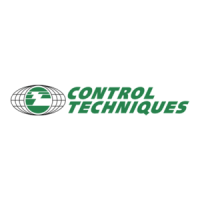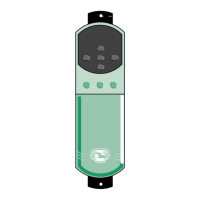Parameter
structure
Keypad and
display
Parameter x.00
Parameter description
format
Advanced parameter
descriptions
Serial comms
protocol
Performance
Menu 3
Mentor MP Advanced User Guide 47
Issue Number: 4 www.controltechniques.com
To analyze the performance of the speed controller it may be represented as an s-domain model as shown below.
where:
Kc is the conversion between the speed controller output and torque producing current. A value of unity at the input to this block gives a torque
producing current equivalent to the rated current of the drive. The drive automatically compensates the torque producing current for flux variations in
field weakening, and so Kc can be assumed to have a constant value. Kc is equal to the rated drive current (see Menu 4 for value of Rated drive
current for each drive size).
Kt is the torque constant of the motor (i.e. torque in Nm per amp of torque producing current).
Kt = Motor rated torque / Motor rated current
L(s) is the transfer function of the load.
The s-domain system above may be used to determine the performance of systems with a relatively low bandwidth. However, the real drive system
also includes non-ideal delays due to the torque controller response, and speed measurement and control delays. These delays, which can be
approximated with a simple unity gain transport delay (T
delay
) as shown below, should be taken into account for more accurate results.
The speed controller gains used in previous Mentor II products were in internal drive units. Conversion between the previous internal units and the SI
units used in this product are given in the table below.
The user may enter the required speed controller gains into Pr 3.10 {SP01, 0.61} to Pr 3.15. However, if the load is predominantly a constant inertia
and constant torque, the drive can calculate the required Kp and Ki gains, provided a value of motor plus load inertia (Pr 3.18) and the motor torque
per amp (Pr 5.32) are setup correctly. The calculated values for Kp and Ki are written to Pr 3.10 {SP01, 0.61} and Pr 3.11{SP02, 0.62} once per
second when one of these setup methods is selected (i.e. Pr 3.17 = 1 or 2). The values are calculated from a linear model assuming a pure inertia
load, not including unwanted delays in the speed and current controllers. The Kd gain is not affected. If Pr 3.17 is set to 2 automatic gain set up is not
active, but Kp is boosted by a factor of 16.
Gain Conversion from previous internal units to new SI units
Kp Kp_old *1.79 / Maximum speed (rpm)
Ki Ki_old * mains freq / (2.97 * Maximum speed (rpm))
Kd Kd_old *3.58 / (mains freq * Maximum speed (rpm))
3.17 Speed controller setup method
Coding
Bit SP FI DE Txt VM DP ND RA NC NV PT US RW BU PS
111
Range 0 to 2
Default 0
Update rate Background (1s) read
+
_
+
+
w*(s)
rads
-1
w(s)
Speed controller
Ki.Kd
_
rads
-1
Kp+Ki/s
Ki.Kd
Kc.Kt L(s)
+
_
+
_
w*(s)
w(s)
T
delay

